Sea Level Risk From Antarctica
Air Date: Week of November 10, 2023
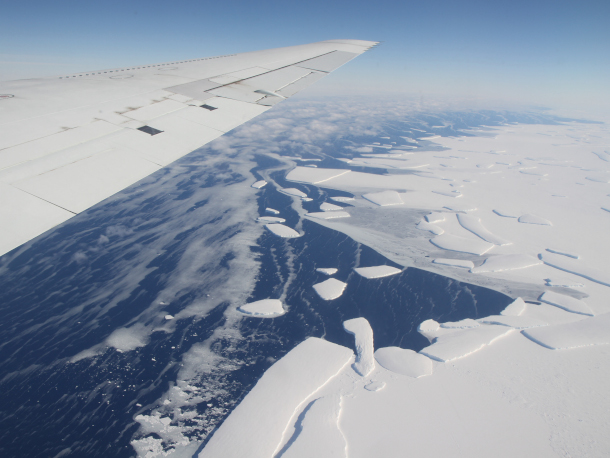
This photo, taken during NASA’s Operation IceBridge to describe ice shelf loss, depicts the calving of an ice shelf located in West Antarctica. (Photo: Jefferson Beck, NASA/GSFC, Flickr, CC BY 2.0)
Antarctica’s ice shelves block glaciers from flowing into the sea but a recent study found that these ice shelves lost 8.3 trillion tons of ice in the last 25 years and are at risk releasing more glacier ice into the ocean. Richard Alley is a professor of Geosciences at Penn State University and joined Host Steve Curwood to shed light on what all this could mean for sea level rise and future ice loss in Antarctica.
Transcript
DOERING: Antarctica's ice shelves are the gatekeepers between the continent's glaciers and the open ocean.
As the planet warms, these shelves shrink, exposing more and more ice, which just leads to more melting.
This frozen continent rests under a massive ice sheet averaging more than a mile thick.
But a recent study in Science Advances found that Antarctica had 68 ice shelves that shrunk significantly between 1997 and 2021, adding up to about 8.3 trillion tons lost during that time.
Richard Alley is a professor of Geosciences at Pennsylvania State University and he joined Living on Earth Host Steve Curwood to shed light on what all this melting at the south pole could mean for the planet.
ALLEY: Yeah, so it is contributing to raising sea level a little bit. Normally what a nice shelf does is they grow for a while. They grow and grow and grow. And then they break off one of these icebergs, and the icebergs can be huge, you know, you'll see the stories, it's as big as Delaware, or it's as big as the Isle of Man or something. So you expect the most of them to be growing and then occasionally breaking off. What we've been seeing recently is a lot more breaking off than you would ordinarily expect. And that's letting the pile spread faster, and it's contributing a little bit to sea level rise. Sea level is rising, and it's rising, because we're warming the ocean and the water expands. It's rising because we're melting ice in Antarctica a little bit, in Greenland a good bit, and especially in mountain glaciers. And the water that was stored up there runs into the ocean and makes it higher. And then we've got faster flow in Greenland and Antarctica into the ocean, which also raises sea level.
CURWOOD: By the way, that same study that we talked about in Science Advances show that 29 Ice shelves grew. I mean, what does that mean for the climate? Any good news there?
ALLEY: It's what we'd expect. So, the Ross Ice Shelf is a famous one, it sorta kinda ended at the same place for the last 6000 years. And what it'll do is it'll advance, it'll grow until it takes a fairly large chunk of ice past Ross Island, and then that chunk breaks off, and then it'll grow. And then that chunk breaks off. And then it'll grow. And it's been doing this for 6000 years. And so you expect most of the shelves to be growing most of the time, because the growing is fairly slow. And the breaking off is fairly fast to make the iceberg.
CURWOOD: Now, continuing in our geology class for a moment longer here, as I understand it, much of the melting thus, so far has been really chipping away at the West Antarctica ice sheet. What's going on in the East?
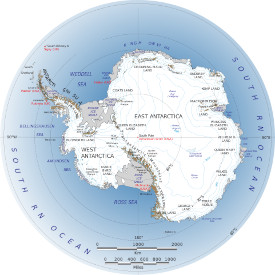
Scientists have considered the western portion of Antarctica to be the main area of concern, due to rapid melting from warming waters, but East Antarctica has also been seeing more melting than originally expected by glaciologists. (Photo: NASA, Wikimedia Commons, Public Domain)
ALLEY: So, the East actually is changing a little faster than we expected. The ice shelves love really cold water and really cold air and they tend to show up in the coldest waters that are common in the world ocean. Warmer waters have an easier time getting up towards the West Antarctic than they do getting up towards the east, for various reasons linked to the winds, and the Amundsen Sea Low, and the atmosphere and a lot of things. So we've been worried about the West because it's easier for warm water to flow in there and attack. But there is some warm water sneaking in in places in East Antarctica, that I think surprised a few people. Me, certainly.
CURWOOD: Now, one study that was recently published says that we have passed the point of no return for the West Antarctic ice shelves. What does that mean? And how soon are we going to feel the impacts of that?
ALLEY: What we're worried about in West Antarctica. Glaciers that go into the ocean have a tendency to be a little like a traffic jam that is hung up by a closed lane in the interstate. They end at a place which is very narrow. They're backed up behind that, they're trying to dump ice out into the ocean. And so the ice tends to end at a place which is fairly narrow and fairly shallow. If you kick it out of the bottleneck, it tends to retreat and dump the non-floating ice into the ocean until it can find another bottleneck to stabilize on. So when Vancouver discovered the ice in Glacier Bay in Alaska, there was no Glacier Bay. The entire bay where you go on a cruise ship now was full of ice. It was a mile thick in the middle. And then that ice was kicked out of the little narrow place that it ended by a little warming. And then John Muir watched the icebergs breaking off boom, boom, boom, boom, boom, boom, boom, and the thing backed up 60 miles, and it thinned by a mile 'til it found some other place to stabilize. What we're worried about in West Antarctica and parts of East Antarctica is that the ice now ends in a bottleneck, a place that is fairly narrow and fairly shallow for dumping icebergs. And if it gets kicked out of there, and retreats, there are these big, deep interior basins. And the next place that can stabilize is the Transantarctic Mountains, and that's about 11 feet of sea level rise. And so we're really worried about West Antarctica because if it does, what we have seen happen in other places, it's so much bigger, that it's a whole lot of sea level rise. And so if we pass a point of no return for West Antarctica, it's a lot of sea level rise.
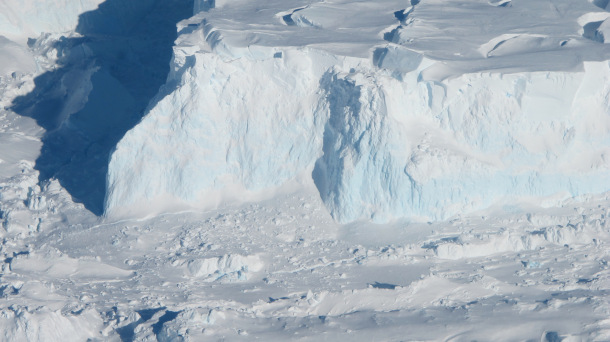
Antarctica’s Thwaites Glacier is considered one of the world’s most important glaciers, due to its size and the amount of ice it holds behind it. (Photo: James Yungel, NASA, Flickr, CC BY-NC 2.0)
CURWOOD: What are we talking about, a lot of sea level rise, and when the sea level rise?
ALLEY: Right, so it could be fast, and exactly how fast we have a very vigorous discussion going on in the community. Over a small number of hundreds of years, it clearly can happen. Some of our modeling and some that I'm guilty of helping with a little bit, says that once it gets started, it could happen in a century, or even less, and huge uncertainty attached to just how fast it could go. But it could be really scary fast as our work shows.
CURWOOD: Hm. What's scary fast?
ALLEY: So we have one model out of many that implemented what we hope is a better version of how icebergs break off the front of cliffs. And in that one, after warming gets large enough to really trigger the fast changes. It was 100 years to dump three meters of sea level. So something like 11 feet.
CURWOOD: Oh, my. So Professor Alley, let's talk a bit about some solutions here. How do we move forward towards a better outcome for Antarctic's ice?
ALLEY: Antarctic's ice cares about warming, it cares about change. The ice shelves love the coldest water in the world ocean. And that means change is bad for them. Because if you change the winds, you change the currents, you change the temperature, it can't get better. But it can get worse, you can't bring in colder water because there isn't any colder water. So changing things is bad for Antarctic ice if you want to keep ice on Antarctica. And so finding the solutions that limit warming is really the thing that Antarctica wants.
CURWOOD: So if we were to implement the goal of the Paris Climate Agreement to keep warming below one and a half degrees Centigrade, or roughly 2.7 degrees Fahrenheit, would that stop this process? Or are we already losing these ice shelves?
ALLEY: It is very clear that wherever we limit warming, we just missed something worse. Even if we were to dump all of West Antarctica, there's a lot more ice in East Antarctica, there's still a lot of ice in Greenland. So whenever we stop the warming, we just missed something worse. And that's maybe the most optimistic view of it is that we can save a lot of ice very clearly. There's this new study out that says there's some chance that we're going to derive some loss from West Antarctica with the warming that we've already caused. But even this new study is actually clear that the most likely future limiting warming limits melt of Antarctica, it limits sea level rise.
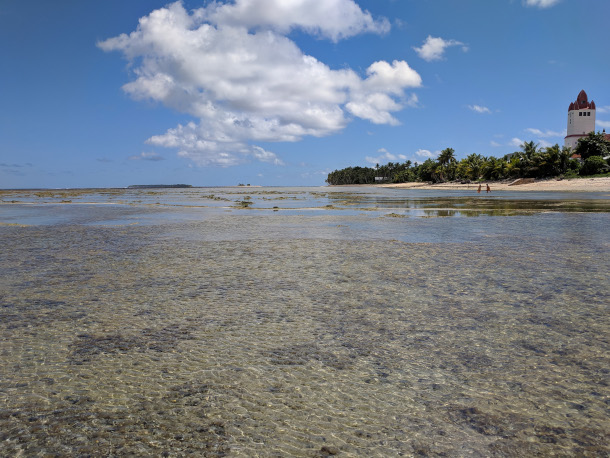
A beach in Tuvalu, one of the world’s most vulnerable countries when it comes to rising sea levels. Richard Alley says a few feet of melting ice won’t mean much for Antarctica, but will have major impacts for the world’s coasts. (Photo: UNDP Climate, TuvaluCoastal Adaptation Project, Flickr, CC BY-NC 2.0)
CURWOOD: How much sea level is trapped in the ice of Antarctica, by the way?
ALLEY: Almost 200 feet of sea level. Not quite, but pretty close to that.
CURWOOD: So if we melt it all? Noah, would have been right, I guess.
ALLEY: If we melt it all, we don't think we're going to melt at all. That's not on the table. But you can get 10 feet out of Antarctica. And it isn't a huge change for Antarctica. It's just a huge change for the coasts of the world.
CURWOOD: Now over the years, we've seen that science, especially when it's been aggregated in the form of the Intergovernmental Panel on Climate Change, has tended to be on the conservative side of seeing the rates of change that are happening in the ecosphere. That, back in the earlier days, it was very much behind. It seems that more recent studies have been closer to what's really going on. But what are the chances that we are sort of understating the risk to our society? I know that's not really a fair question. But you know, a lot of people are curious about this.
ALLEY: Yeah. So it's a very fair question. I worked a good bit with the UN, the Intergovernmental Panel on Climate Change, I'm deeply impressed by what they do. It's a huge number of volunteers who are spending their nights and weekends trying to give the public the best they can do. But on sea level, it's clear that there has been a tendency to be on the conservative side, on the low side. And I think that's because of the nature of the uncertainties that you make your best estimate. And those best estimates leave most of the ice on Antarctica, they leave most of the ice on Greenland. And so you can't be much better than that. But you can be worse. And so I think that we're finding out that there's an uncertainty in your estimate. That usually means that you end up on the high side, not the low side for how much sea level rises.
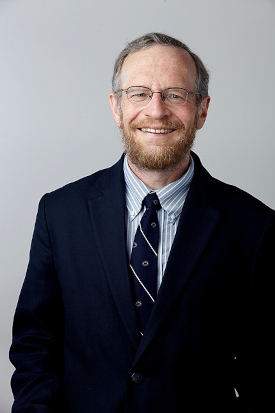
Richard Alley is a geoscientist and Evan Pugh Professor of Geosciences at Pennsylvania State University. (Photo: The Royal Society, Wikimedia Commons, CC BY-SA 3.0)
CURWOOD: Before you go, Professor. You've been at this a while. How has your perspective changed?
ALLEY: When I started In this field, the idea that we were going to limit warming was important. We know that there was huge value in doing so. And I don't think we had much of a clue how we could do that. And I think we were very much afraid that it was going to be very, very expensive to do that. The amount of technological improvement that's happened since, what we've learned. Solar cells, when I was a student, they put them on satellites. You probably had a hand calculator with a solar cell, and they weren't good for much else. And now, you know, the experts have looked at this and said that they are making the cheapest electricity in human history, the cheapest electricity in human history from utility scale solar, from the International Energy Agency saying this, and I really do think now that we know how to fix it. We know how to fix it technically, we know how to fix it economically. I have served on committees with really brilliant and highly awarded economists, whose work shows that we help the economy as well as the environment if we get busy on this.
CURWOOD: Haven't figured out how to do it politically yet though, have we?
ALLEY: Well, you have a lot of listeners.
DOERING: That’s Penn State geologist Richard Alley speaking with Living on Earth Host Steve Curwood.
Links
Living on Earth wants to hear from you!
Living on Earth
62 Calef Highway, Suite 212
Lee, NH 03861
Telephone: 617-287-4121
E-mail: comments@loe.org
Newsletter [Click here]
Donate to Living on Earth!
Living on Earth is an independent media program and relies entirely on contributions from listeners and institutions supporting public service. Please donate now to preserve an independent environmental voice.
NewsletterLiving on Earth offers a weekly delivery of the show's rundown to your mailbox. Sign up for our newsletter today!
 Sailors For The Sea: Be the change you want to sea.
Sailors For The Sea: Be the change you want to sea.
 The Grantham Foundation for the Protection of the Environment: Committed to protecting and improving the health of the global environment.
The Grantham Foundation for the Protection of the Environment: Committed to protecting and improving the health of the global environment.
 Contribute to Living on Earth and receive, as our gift to you, an archival print of one of Mark Seth Lender's extraordinary wildlife photographs. Follow the link to see Mark's current collection of photographs.
Contribute to Living on Earth and receive, as our gift to you, an archival print of one of Mark Seth Lender's extraordinary wildlife photographs. Follow the link to see Mark's current collection of photographs.
 Buy a signed copy of Mark Seth Lender's book Smeagull the Seagull & support Living on Earth
Buy a signed copy of Mark Seth Lender's book Smeagull the Seagull & support Living on Earth

